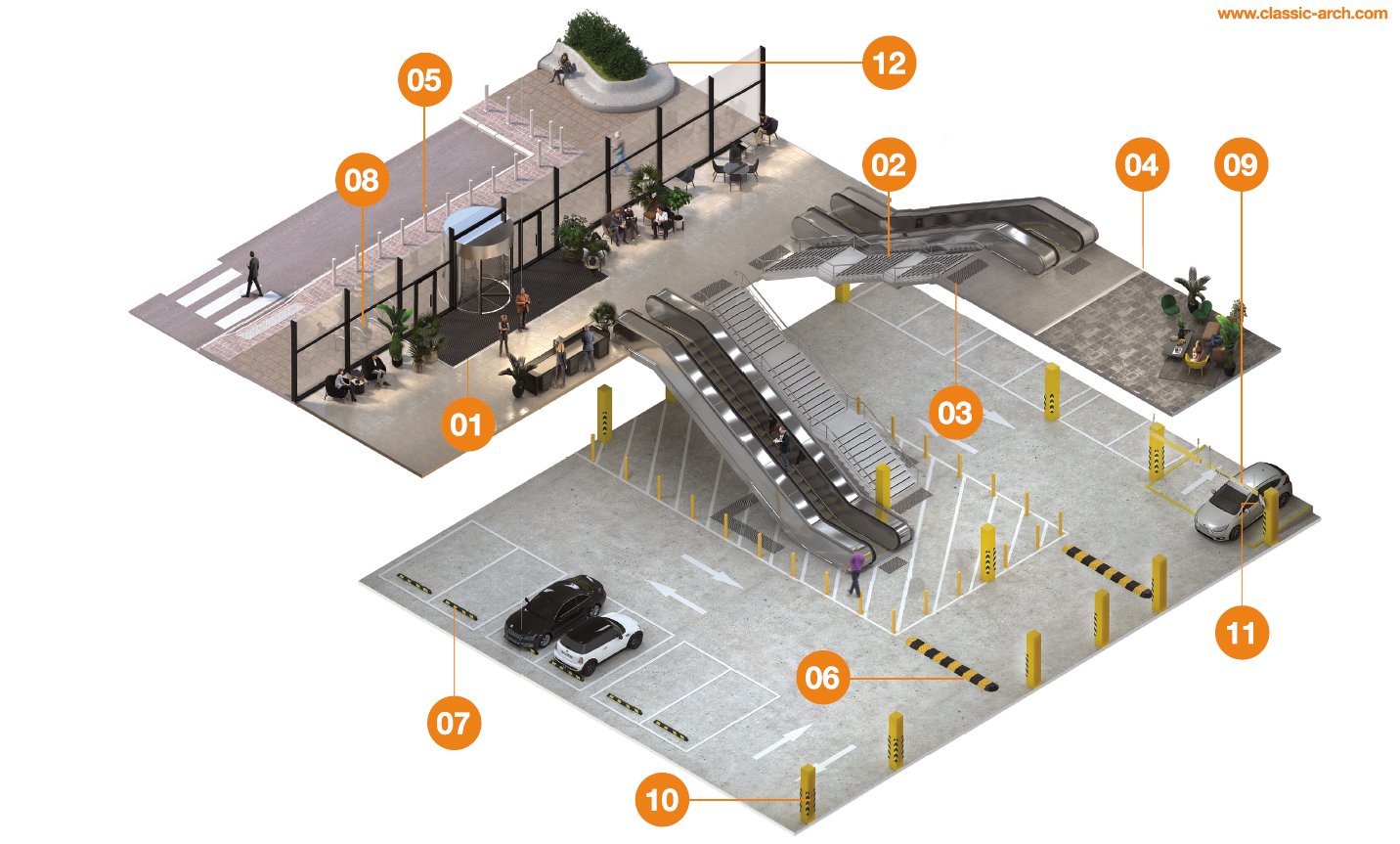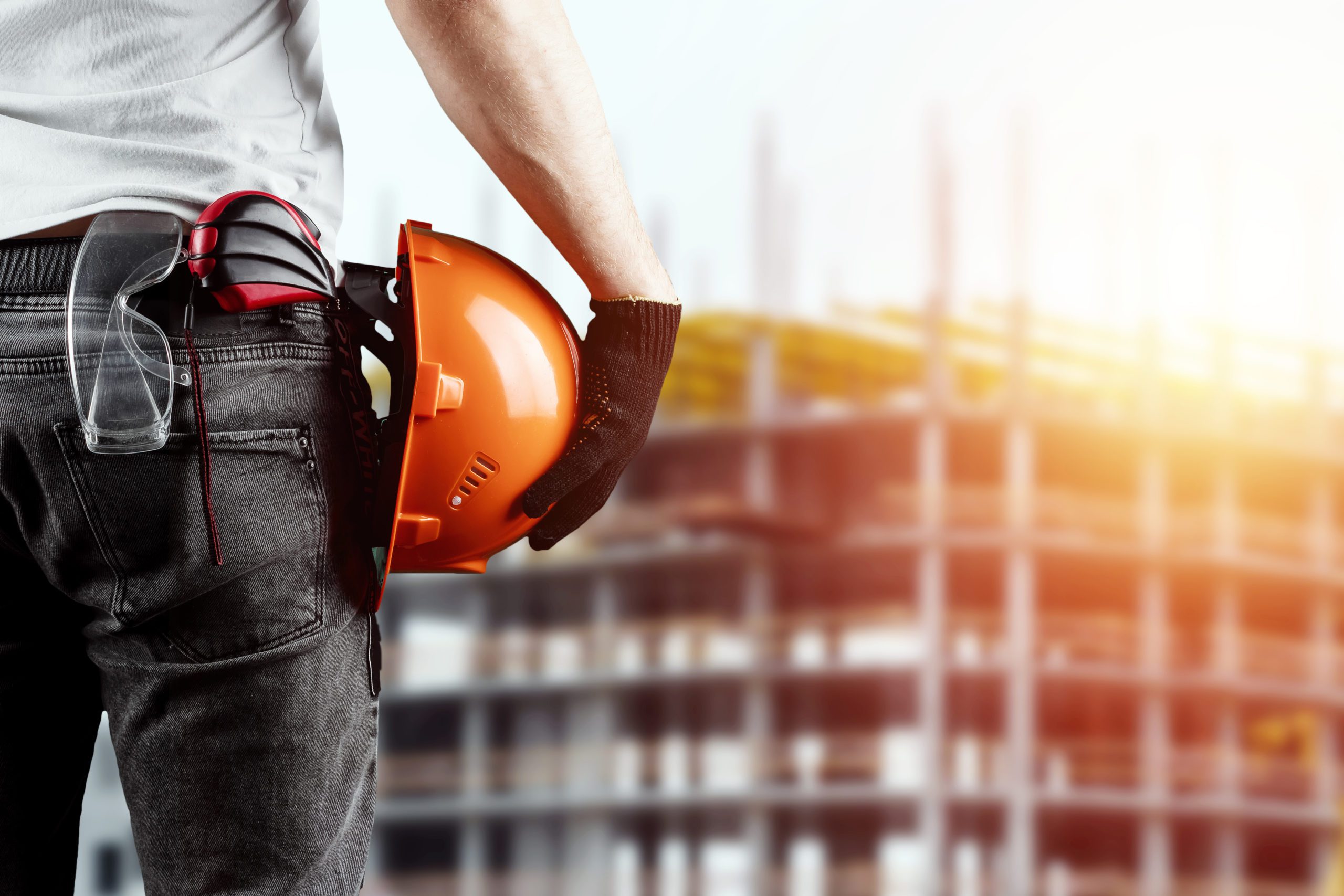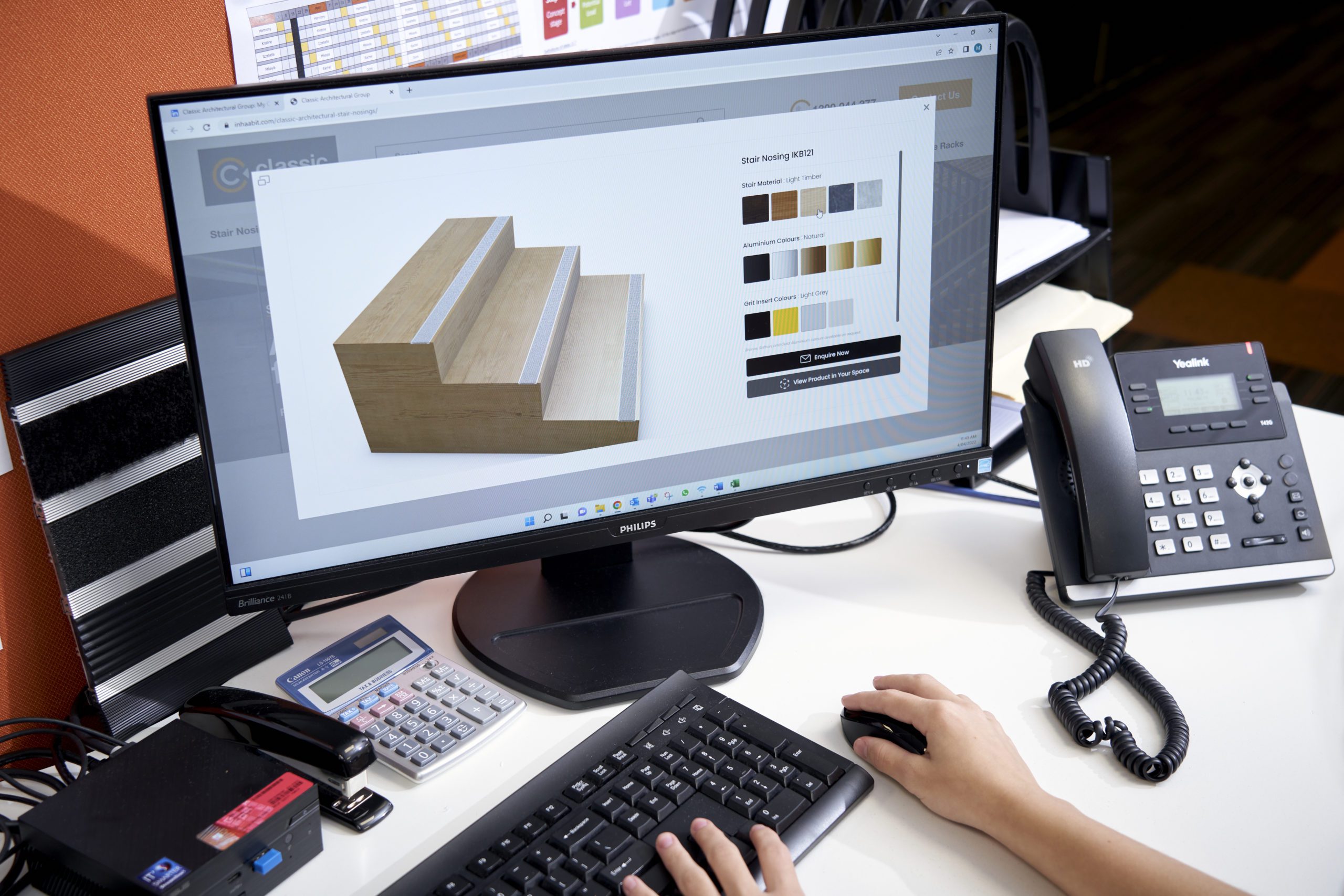When it comes to designing public spaces, safety is more than just a checklist — it’s essential to the flow of pedestrians, traffic and more. Apart from safety considerations, public places should be designed in a way that everyone can move through, interact with, and enjoy the space without risk. Whether you’re building a new office, upgrading a shopping centre, or redesigning a public park, following the right safety standards is key to protecting both people and property. These safety standards ensure public spaces are accessible and secure for all users, including those with visual impairments. When you’re working on creating a space like this, you need to work with a supplier and partner who understands the local landscape and federal safety regulations.
Classic Architectural Group is a trusted brand across Australia, with safety being the key focus in public spaces. Adhering to Australian Safety Standards and listening to their customers, regulators and partners for over 30 years, the products are developed to be versatile in terms of design, colours and application.
Let’s look through a building example, see what safety standards apply to the visual diagram, and how the Classic range can help your project:

01: Entrance Matting
What is it?
Entrance matting is placed at building entry points to create cleaner, safer entrance areas. It maintains cleanliness, reduces slip hazards, and protects interior floors from damage. It helps trap dirt, moisture, and debris from shoes, preventing them from being carried inside. Entrance mats are typically made from a combination of materials like textile fibers, rubber, and aluminium, and can be designed to scrape dirt or wipe moisture.
Entrance Matting Australian Standards
Mat size is critical. People entering a building don’t often stop to wipe their feet so it’s important that an entrance mat is deep enough to ensure there are enough contacts between the entry matting and the soles of shoes to minimise the amount of dirt carried into the building.
The Australian Building Code’s recommendation is that a mat should have a minimum dimension of 1.8m from front to back which allows for 2 contacts from each foot. However, studies* have proven that fitting an entrance with 6m of an effective entrance matting system can stop 94% of all walked in dirt and moisture. *TUV Rheinland
Entrance mats are not always a “standard” shape, that’s why it’s important to have all sites measured and cut into any shape or form providing the solution for architecturally shaped entrances and revolving doorways, which adhere to code standards.
How Can Classic Architecture Group Support Your Project?
Classic Architectural Group provides customised commercial entrance mats for both interior and exterior use, helping to lower floor maintenance costs and reduce slip risks. Designed to complement your building’s décor, our mats come in recessed and surface-mounted options, offering long-lasting durability. Installed flush with the surrounding floor, they are securely fixed in place to allow smooth, unobstructed movement for both foot and wheeled traffic.
02: Stair Nosing
What is Stair Nosing?
Stair nosing is a safety feature applied to the edge of stairs to enhance grip and prevent slips. They can improve visibility, reduce slip hazards, and protect the stair edges from wear and tear. Typically made from materials like aluminium, fibreglass, rubber, or vinyl, stair nosings provide additional grip, making stairs safer, particularly in high-traffic areas.
They come in various designs, including options for different floor coverings like carpet, vinyl, or concrete. Stair nosings are essential for both aesthetic appeal and compliance with safety standards.
Stair Nosing Australian Standards
Australian Stair Nosing Standards (AS 1428.1:2009) state the following requirements are mandatory to fully comply with all public access stairs (2 or more):
- to be fitted with stair nosing that has a fully non-slip horizontal surface
- each tread shall have a strip not less than 50mm and not more than 75mm deep across the full width of the path of travel. The strip may be set back a maximum of 15mm from the front of the nosing
- not project beyond the face of the riser and the riser may be vertical or have a splay backwards up to a maximum 25mm
- have stair nosing with a luminance contrast of at least 30% against the surfaces
These standards are compulsory in new construction, however existing stairs in any publicly accessible areas should also comply to ensure a “duty of care” compliance is met.
To ensure you meet current build codes, it is important to discuss options with one of Classic’s highly skilled professionals who will provide you with all the options available to meet both aesthetic and compliance requirements.
How Can Classic Architecture Group Support Your Project?
Classic Architectural Group’s Tredfx anti-slip stair nosings offer a professional finish to stair and ramp areas. With an equal focus on safety and aesthetics, our stair nosing is designed for commercial-grade use.
Available in a variety of materials, including fibreglass, aluminium, and options for carpet, vinyl, and rubber surfaces, our stair nosings provide superior traction. With solutions for various environments and substrates, Classic offers durable and stylish stair tread products that ensure added safety and accessibility.
03: Tactile indicators
What are Tactile Indicators?
Tactile indicators are raised surfaces that assist people with vision impairments. In public places, they help navigate pathways safely by providing tactile feedback underfoot. Commonly found on pavements, stairs, and train stations, they can either be in warning or directional forms and must meet specific size, shape, and colour contrast standards.
Tactile Indicators Australian Standards
There is a very extensive document on the safety standards of AS1428.4.1:2009 relating to tactile indicators, but below is a basic summary relating to size, shape and colour:
Size and Shape Requirements:
- Warning / hazard tactile indicators incorporate a grid pattern of studs at 50mm-centres. They are raised, truncated cones with a base diameter of 35mm, no higher than 5mm and a top diameter of 25mm.
- Directional / leading tactile indicators incorporate rows of parallel bars with rounded ends spaced 50mm apart, end to end, and at 75mm centres side by side. They also have a chamfered side with a base of 35mm by approx. 285mm long and 5mm high.
Colour Requirements:
- Tactile Indicators must have a luminance contrast to the surrounding ground surface, i.e., light grey tactile indicators installed to light grey concrete will not achieve a luminance contrast.
- 30% minimum luminance contrast to the surrounding ground surface is required where the Tactile Indicator is in the form of a precast concrete paver or tile or mat with a uniform colour (defined as being ‘integrated’).
- 45% minimum luminance contrast to the surrounding ground surface is required where the tactile indicator is an individually drilled and fixed stud or bar (defined as ‘discreet’).
- 60% minimum luminance contrast to the surrounding ground surface is required where the individually drilled and fixed tactiles have a different colour top than the side – the 25mm diameter top must exhibit the minimum 60% luminance contrast. If two colours are being used, the 60% rule also applies.
How Can Classic Architecture Group Support Your Project?
Classic Architectural Group’s Tredfx Tactile Systems provide both directional guidance and alerts for potential hazards. Available in a range of materials — including stainless steel, aluminium, solid brass, fibreglass, poly, and ceramic — our tactile solutions cater to various aesthetic and functional needs. We offer both warning and directional indicators that comply with all NCC and Australian Standards, ensuring full accessibility and safety. Custom-designed to fit your project’s specifications, our systems also undergo luminance contrast testing (LRV) to meet visibility requirements. With over 40 years of experience, Classic provides end-to-end solutions for public access safety, including stair nosings, entrance mats, and car park safety systems.
04: Trims & Expansion Joint Covers
Trims and expansion joint covers are used to manage movement and protect surfaces in tiled or floor areas. They protect the structural gap that accommodates shifts due to temperature changes, vibrations, or settling, preventing damage to flooring. Trims are installed at the edges of tiles or flooring to create smooth transitions between different surfaces, providing a clean and finished look.
05: Bollards
What are Bollards?
Bollards may be used to control or prevent vehicle access to public places or to provide visual enhancement to a space and their style should be compatible with other street furniture in the area.
Australian standards for bollards
Bollards that form the sole means of preventing vehicular access should be spaced at 1.6m apart. This should prevent most cars sold in Australia from driving between them. They should be approximately 1 metre in height and include a reflective panel if sited in a vehicle domain such as a car park. The space between a bollard and a gutter or kerb should allow for pedestrian movement (including people with disabilities) and for vehicle overhangs and door openings.
Australian standards for bollards dictate that they must be visible to motorists, cyclists and pedestrians. Bollards should not be a hazard to people with disabilities. They should not be located in the natural desired pedestrian path. They should have sufficient foundation strength to resist being pushed by a large 4×4 vehicle.
How Can Classic Architecture Group Support Your Project?
Classic is your one-stop solution for all your bollard needs. We offer general-purpose and heavy-duty bollards in various diameters, along with removable, collapsible, and breakaway options. From the early-works phase through to final fitout, we’re here to provide compliant solutions for every stage of your build.
06: Speed Humps
What is it?
Speed humps are raised barriers that can slow down vehicle traffic. They are used all over public spaces — residential areas, school zones, car parks — to improve safety for pedestrians, cyclists and drivers.
What’s the standard?
The Australian standard that regulates the design and use of speed humps for use in off-street parking in Australia is ‘AS2890.1:2004 parking facilities’.
AS2890.1 identifies four main criteria in the design of ‘type 2’ speed humps.
- Height: Must be between 25mm and 75mm.
- Cross section: Must be flat on top. (Not round)
- Ramp angle: Must have a ramp angle 2:1
- Markings: Must have alternating parallel yellow or white stripes 250mm wide.
Road humps shall be spaced at no less than 10m for type 2, along any one aisle or roadway. Maximum spacing where required to control speeds continuously along a roadway should be about 50m, speed hump should be located clear of intersections and curved roadways.
Speed humps shall not impede pedestrian or wheelchair traffic on any accessible travel path provided for people with disabilities.
How Can Classic Architecture Group Support Your Project?
High-quality and hard-wearing, Classic Speed Humps are available in economy recycled rubber and virtually indestructible heavy duty steel. Prevent speeding around schools, parks, secondary roads, transport depots, factories and terminals.
07: Wheel Stops
What are Wheel Stops?
Wheel stops are low barriers placed at the end of parking spaces and spots. They prevent vehicles from damaging property. They help guide drivers into parking spots and park without hitting the curb.
Wheel Stop Australian Standards
Australian wheel stop placement standards (AS2890.1:2004) state that:
- Wheel stops shall be between 90 and 100mm in height, and 1650 + 50mm in width.
- Distances are measured from the front of the parking space to the point of contact with the vehicle tyre. If wheel stops are provided to restrain vehicle contact with a kerb higher than 150mm or a wall, a further 200mm shall be added to the wheel stop distance.
- The maximum height of wheel stops is 100mm. Most concrete wheel stops do not comply with the standard as they exceed the maximum height.
How Can Classic Architecture Group Support Your Project?
Practical and durable, our range is easy to install and includes rubber and concrete. Our wheel stops are moulded in one piece and reinforced for strength and durability. Ensure that your car park is safe and has proper directions for parking with wheel stops.
08: Bike Racks
What is it?
Bike racks are structures designed to hold bicycles. Used in public or private spaces, they are used to lock bicycles up. Bike racks help prevent theft, encourage cycling, and can be commonly found in public areas and car parks.
Bike Racks Australian Standards
Available in a wide range of applications, they can be surface mounted or below ground. Unless the frame and both wheels of a bicycle can be locked to a facility, it cannot be regarded as secure and will not therefore meet the requirements of the Australian Standards.
How Can Classic Architecture Group Support Your Project?
Ideal for public access areas and shared spaces including schools, shopping centres, walkways and railway stations, Classic Architectural Group offers versatile commercial bike racks and car park safety options to suit all applications. Our range includes hoops, wall-mounted, surface-mounted, vertical racks, horizontal racks, multi-bay and dynamic bike rack models.
09: Height Bars
What is it?
Height bars are the physical bars installed above entrances to limit the clearance height of vehicles. They allow only appropriately sized vehicles to enter certain areas. They prevent taller or oversized vehicles from causing damage to property.
What’s the standard?
To comply with AS2890.1-1993, height bars need to be powder-coated with high-visibility safety yellow, have reflective red/white panels, display and specify the required clearance, and be manufactured from durable galvanised steel tube.
How Can Classic Architecture Group Support Your Project?
Classic height bars are designed to restrict oversized vehicles and protect other vehicles and property from damage. They are essential to car parks, but can also be found in petrol stations and drive-throughs. The aluminium tube is powder coated safety yellow with red and white reflective diagonal stripes.
10: Corner Guards
What is it?
Corner guards are protective devices installed on building corners or edges to prevent damage from accidental bumps or impacts. They are robust enough to absorb shocks and protect both the structure and vehicles.
How Can Classic Architecture Group Support Your Project?
Corner guards are designed to prevent damage to both vehicles and property, particularly in areas of restricted space. Ideal for loading docks and car parks. Made from recycled rubber with reflective panels.
11: Safety Mirrors
What is it?
Safety mirrors are reflective devices installed in areas with limited visibility, such as intersections, parking lots, or blind corners. They help improve visibility for drivers, pedestrians, and cyclists, reducing the risk of accidents.
How Can Classic Architecture Group Support Your Project?
Convex safety mirrors are a great resource for traffic and security solutions. They provide a greater field of vision and can assist people in seeing hazards and thus preventing collisions, making it safe for pedestrians and other traffic, especially in areas where forklifts are used.
Classic’s safety mirrors are made from unbreakable polycarbonate face, they are weatherproof, adjustable to any angle and suitable for interior and exterior applications.
12: Skate Deterrents
What is it?
Almost every commercial building and streetscape, as well as external public areas and piazzas, is at the mercy of those who sue them. Property and facility managers spend hundreds of thousands of dollars every year in time and money on costs associated with clean-up and repairing damage caused by skateboarders, in-line skates and bikes.
Skate deterrents are installed in public spaces to prevent skateboarding or other forms of skating on inappropriate surfaces. These include metal disks or sloped edges designed to make skating uncomfortable or difficult. Commonly found on railings and curbs, skate deterrents protect property and reduce safety risks.
How Can Classic Architecture Group Support Your Project?
Classic’s Skatestop Skate Deterrents help to protect your landscape. Our skateboard deterrents save you time and money on potential damage costs caused by skateboarders, in-line skates and bikes. They also reduce your liability for personal injury to passersby.
Classic Architecture Group has an extensive knowledge of the safety standards and what is required to deliver exceptional results for their customers. This places their innovative strategy of access solutions ahead of the pack, supported by an enduring commitment to quality and service that allows space for individual excellence, success and fulfilment. To have one of their team members quote up your project to ensure all safety requirements are fulfilled, contact 1300 244 377 or info@classic-arch.com.






